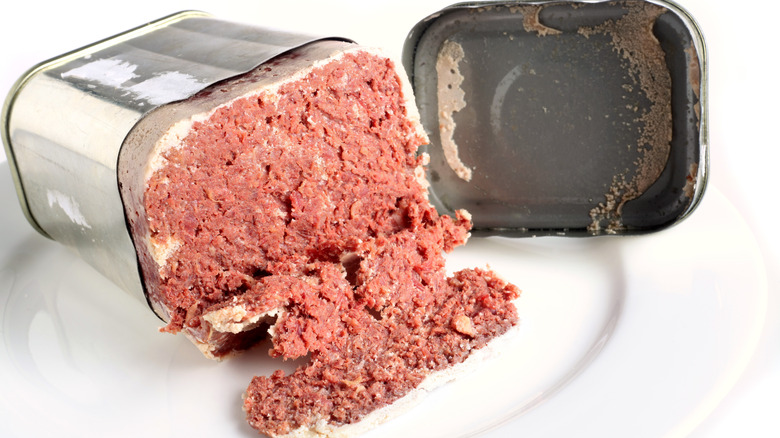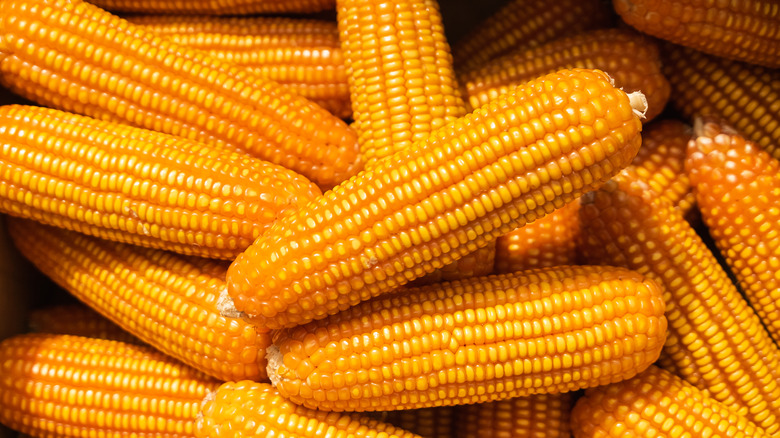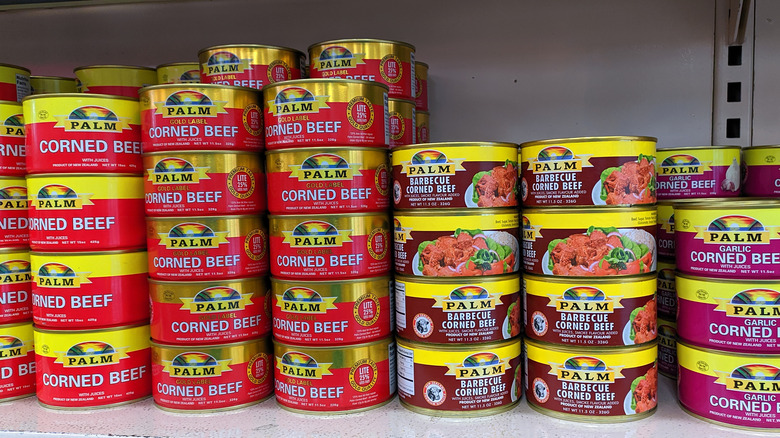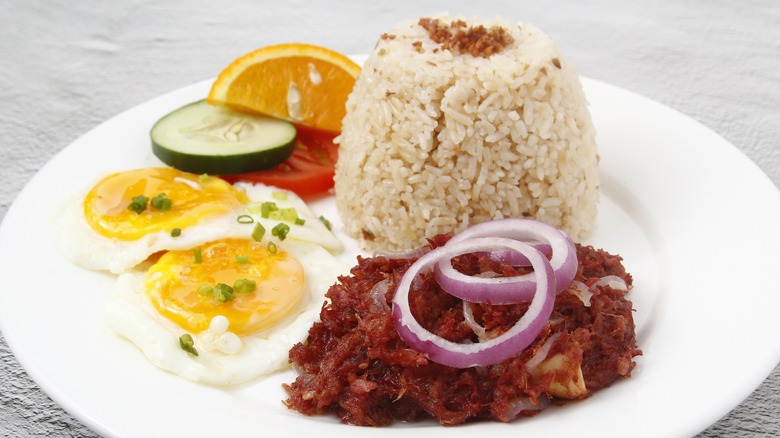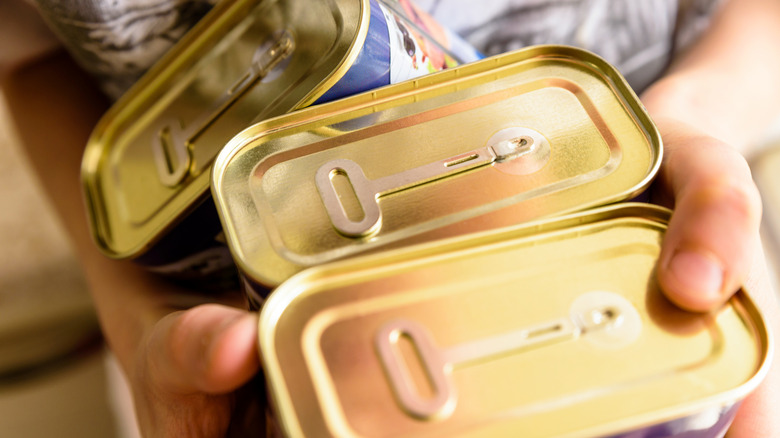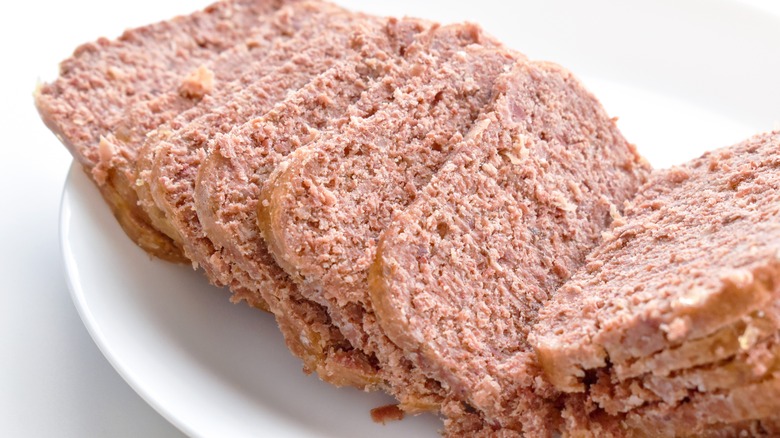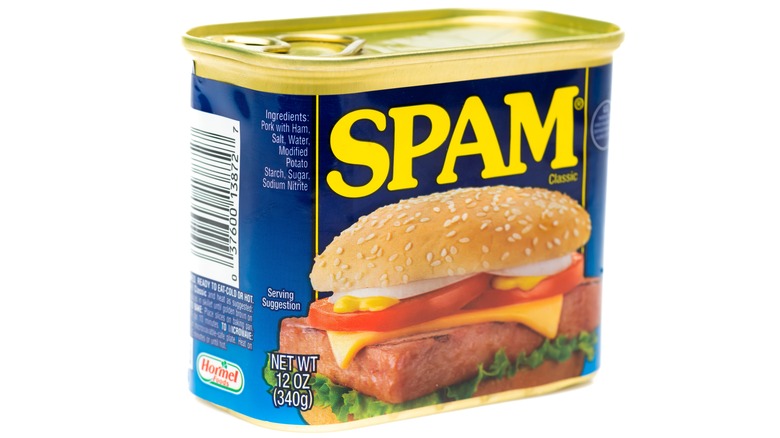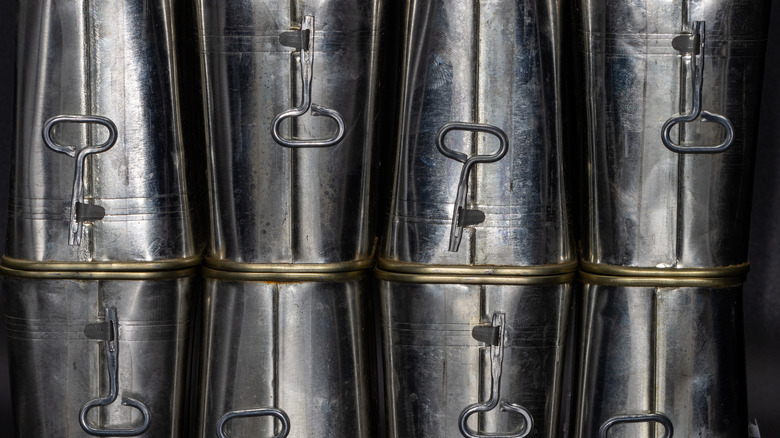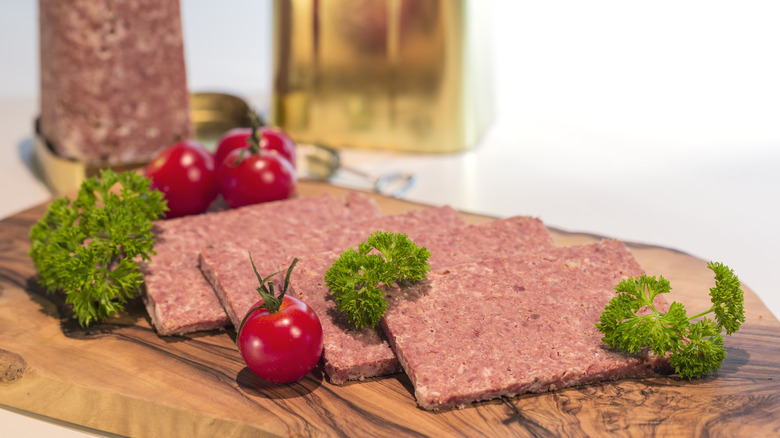The Biggest Myths About Canned Corned Beef
Also sometimes called bully beef, canned corned beef has been an American staple for decades. The crumbly, pinkish-brown product is made from beef brisket — the breast portion of the cow — cooked in curing brine (via The Rusty Spoon). The meat usually comes in distinctive tapered rectangular cans., and there's a good reason for this. Canned corned beef was supplied to the military during both World Wars, and the powers that be quickly worked out that rectangular tins were easier to stack than round tins, saving space during transport (via FoodHow).
Over the years, canned corned beef has been blamed for a multitude of disasters, from obesity in Tonga to deforestation in South America. In fact, The Guardian has referred to it as "a food dogged by an aura of crisis, deprivation, and controversy." Despite its questionable reputation, many swear by the salty, somewhat oily flavor of canned corned beef. The meat is also the main ingredient in many popular recipes across the globe such as the beloved corned beef hash.
Whether you love canned corned beef or believe that the meaty mush deserves the bad rap, here are the biggest myths that still plague this popular food.
Canned corned beef contains corn
Despite what its name may suggest, corned beef has absolutely nothing to do with corn — that is, unless you are using it to make a recipe that requires the ingredient. Instead, the term corned beef was used by the British in the 17th century to refer to the salt crystals — which were approximately the size of kernels — used to cure the meat (via Smithsonian Magazine). According to the Kitchen Project, the word corned is a version of the old Germanic word Kurnam, which means small seed.
While traditionally corned beef was cured by rubbing salt into the meat, the production today usually involves a salt brine (via U.S. Department of Agriculture). And this is good news since the process lets manufacturers add more than just salt to the recipe. Some favorites that are often incorporated into the brine include mustard seeds, coriander seeds, and peppercorns — all adding to the flavor of the final product.
Canned corned beef is a recent invention
While it was the British who invented the term corned beef in the 17th century, the canned classic draws on a long tradition. Mark Kurlansky writes in his book "Salt" that the Irish were already using salt crystals to preserve meat in the Middle Ages. The first mention of the dish appears in the 12th-century Gaelic poem "The Vision of MacConglinne," where it's referred to as a luxury item given to the king (via Science Direct). In addition, The Nibble reveals that there's a 14th-century English recipe for hache or hachy, which is likely to be the predecessor of today's hash.
The rectangular corned beef can we know and love today was patented in Chicago by Arthur A. Libby back in 1875 (via The Food Timeline). However, canned corned beef didn't become popular in America until World War II when it was distributed to households as a food supplement (via Eat Delights). Today, dozens of canned corned beef cans are found on supermarket shelves across the U.S. Notably, Libby's is still one of the favorites.
Canned corned beef is a traditional Irish food
Served with cabbage across the U.S. on St. Patrick's Day, it's not hard to see why corned beef might be associated with Ireland. In fact, this is a misconception. Traditional St. Patrick's Day feasts in Ireland typically consisted of bacon and cabbage, since historically beef was way out of the price range of the common folk (via History Channel). And even today, the only restaurants that serve corned beef and cabbage on St. Patrick's Day in Ireland are ones that cater to tourists (via Irish Culture and Customs).
So how did Ireland become associated with corned beef? Traditionally, cows in Ireland were used for dairy production and fieldwork and were only slaughtered once they got too old for their tasks. This all changed after the enactment of the British Cattle Acts in the 17th century, which prohibited the import of live cattle into Britain. With farmers forced to slaughter cows and preserve beef with salt before exporting it, Ireland became the center of corned beef production. And the fact that the salt tax in Ireland was around one-tenth of that in England only helped to spur the industry (via Smithsonian Magazine).
There's no difference between deli corned beef and canned corned beef
Canned corned beef is a very different beast than the corned beef you may find at your local delicatessen. Canned corned beef is cured in brine and contains a host of preservatives and additives to preserve its shelf-life. Deli corned beef, on the other hand, is a cured or pickled brisket that's later cut into pieces as desired (via FoodHow).
Deli corned beef originated among America's Jewish community who ate it as a kosher substitute for spam, which contained pork (via Eating Expired). When Irish immigrants started coming to America during the Great Irish Potato Famine in the mid-1800s, they found the beef to be much more affordable than in their home country (via Technological University Dublin). And it wasn't long before they started buying corned beef from Jewish butchers as a substitute for the bacon and ham they were accustomed to eating in Ireland (via Smithsonian Magazine).
Canned corned beef is only popular in the US and Europe
From Reuben sandwiches to corned beef hash, there's little doubt that corned beef is a hit in the U.S. and Europe. However, over the years, the canned food has also won the hearts of numerous far-flung countries, such as the Philippines and Jamaica. The widespread popularity of canned corned beef can be attributed to Britain and France, which both distributed the food to their colonies in the Americas, Africa, and Asia (via We Are Not Foodies).
The presence of the American military in the Philippines led the Southeast Asian country to incorporate canned foods such as corned beef and Spam into local dishes. For example, one of the country's most popular breakfast recipes is cornsilog, a concoction of corned beef, fried egg, and garlic rice (via Vice).
Bettina Makalintal, who moved from the Philippines to the U.S. when she was a child, writes for Vice: "Corned beef is something I can't disassociate from the simple pleasures of my childhood breakfasts. For me, it's only ever paired with the smell of sizzling garlic, the steam that billows out of the rice cooker, and the crackle of eggs frying in a pan deep with oil."
Most canned corned beef is produced in the US
The idea that the U.S. is a manufacturer of canned corned beef is a misconception. While historically Ireland was the leading producer of corned beef, South America took the honors sometime around the outbreak of World War II. More specifically, Fray Bentos in Uruguay became the major producer of the food in the first half of the 20th century, exporting 16 million cans of corned beef in 1943 alone (via Recipe Reminiscing).
Today, Brazil produces 80% of the world's canned corned beef supply, mainly due to its vast swaths of land for cattle grazing. Unfortunately, cattle production is also currently the top contributor to deforestation in the country. In 2017, the world's largest beef producer, JBC, was fined $8 million for the illegal destruction of the Amazon rainforest (via Earthsight). Also in 2017, the Jamaican government banned imports of Brazilian corned beef after an investigation found that several meat producers were selling spoiled meat (via Dig Jamaica).
It's best to eat corned beef straight out of the can
While it's perfectly safe to eat corned beef straight out of the tin, it may not be the most satisfying experience. Since the beef is preserved in brine with salt crystals, corned beef tends to be very salty if left uncooked. Simmering corned beef in water, for example, can leach out a lot of the salt, highlighting the pleasantly meaty taste.
Corned beef makes a great addition to hearty meals and there are plenty of quick recipes out there bound to tickle your fancy. Aside from the classics such as corned beef hash, some other popular concoctions include spaghetti with canned corned beef, canned corned beef fritters, and canned corned beef cabbage turnovers (via The Rusty Spoon). The seasoning that's usually added to these recipes is also a great way of masking any remaining saltiness in the corned beef. Alternatively, you can serve corned beef with sauerkraut or pickles since anything tart also masks salt.
Canned corned beef is healthy
While canned corned beef can be a decent source of vitamins and minerals, it's also filled with plenty of nasties, which means that it's best to keep it in your pantry as an occasional treat. First, for the good stuff — three ounces of corned beef is packed with 15 grams of protein, 1.6 micrograms of vitamin B12, 1.8 milligrams of iron, and 28 micrograms of the antioxidant selenium (via Healthline).
Despite the merits of canned corned beef, the news is far from good. Since corned beef is made from brisket which tends to be tough and fatty, it needs to be tenderized in brine salt. As such, corned beef is full of sodium, with a three-ounce portion loaded with 827 milligrams of sodium and 83 grams of cholesterol. Most canned corned beef also contains the preservative sodium nitrite, which has been linked to cancer and health risks during pregnancy and in infants (via SF Gate). Brisket is also incredibly fatty, and one-third of the fat is saturated (via Healthy Food for Living).
In 2015, the cancer research agency at the World Health Organization classified processed meats, such as canned corned beef, as a Group 1 carcinogen that is likely to cause cancer in humans. To make matters worse, the agency also classified red meat as a Group 2 carcinogen, or probably carcinogenic to humans. Enough said!
Canned corned beef is the same as spam
Canned corned beef and Spam have a lot in common. They are both pre-cooked and processed, served in rectangular cans, and safe to eat straight out of the tin. In addition, they both look like a gelatinous pink meaty mass. Nevertheless, there's one crucial element that sets the two foods apart — corned beef is made with beef while Spam is made with pork.
Launched in 1937, Spam is made with six basic ingredients: pork, salt, potato starch, sugar, water, and sodium nitrite. According to the "The Oxford Encyclopedia of Food and Drink in America," Spam was invented "as a way to peddle the then-unprofitable pork shoulder" (via Time). In addition, Spam tends to have a smoother texture than corned beef and as such, is commonly used on sandwiches, whereas corned beef often features in stir-fries, casseroles, and other recipes (via Foods Guy).
You need the key to open a can of corned beef
Corned beef usually comes in rectangular cans that are opened with an attached key. To open the can, you simply insert the tin's metal tab into the small slot in the accompanying key. The key is then rolled around the can, pulling the tab and separating the tin into two parts. Since cans of corned beef are opened on the side, rather than the top like regular cans, a missing or broken key could pose a problem. Luckily, while opening a can of corned beef without a key can be a nuisance, it's certainly not impossible.
According to Food Cheats, you can use a regular can opener to open a tin of corned beef — provided that you heed some very specific advice. First, it's best to use a large can opener with a comfortable handle for a steady grip. Next, if the top of the can of corned beef is smaller than the bottom, opt to open it at the bottom end as this will make it easier to maneuver around the can's corners. Once opened, use the gadget to make a couple of holes on the other end of the can. This will help the meat slide out of the can easier. And if you don't happen to have a can opener, you can always try using a pair of pliers to grip the tab and slowly peel the strip off the can (via Home Cook World).
Canned corned beef is naturally pink
Some people may not know that the gelatinous pink meaty mass that is canned corned beef would appear gray without one crucial ingredient — sodium nitrite. And the food additive doesn't just enhance the meat's appearance; it also acts as a preservative (via Simply Recipes). However, while sodium nitrite helps to inhibit bacteria in cured meat to keep us safe from food poisoning, the chemical has been linked to numerous health problems. Regular consumption of cured meats such as corned beef, as well as ham and bacon, has been connected to an increased risk of cancer (via Cancer Treatment Centers of America). In fact, because sodium nitrate is toxic in large amounts, it's dyed pink to prevent chefs and home cooks from accidentally using it as table salt.
You can also buy corned beef that hasn't been cured with sodium nitrate. The result is gray corned beef that gets its color during a natural saltwater brining process and hasn't been treated with preservatives. It is sometimes referred to as New England corned beef, and while it's just fine to eat, it's color can certainly make it seem less than appetizing (via The Rusty Spoon).
Canned corned beef is boring
There's more to corned beef than meets the eye. In fact, the cured meat was once at the center of an international scandal — or more specifically an out-of-this-world scandal. On March 23, 1965, astronaut John Young smuggled a corned beef sandwich aboard the Gemini III in the pocket of his spacesuit. Young offered the sandwich to the mission commander, Virgil "Gus" Grissom, around two hours into the five-hour exploratory mission. Seemingly aware of the potential dangers, Grissom promptly stowed the contraband gift in his own space suit pocket (via NASA).
While taking the corned beef sandwich into space was supposed to be a joke, many were concerned that any free-floating food particles — including crumbs of corned beef — on a space shuttle could have had dire consequences. After all, there's a good reason why, at the time, NASA was supplying its astronauts with gelatin-coated food cubes (via Smithsonian).
Since a part of the Gemini III mission was testing space food, Young's joke didn't go down well with the powers that be on the ground. Young recalls the experience in his memoirs, "Forever Young," saying, "A couple of congressmen became upset, thinking that, by smuggling in the sandwich and eating part of it, Gus and I had ignored the actual space food that we were up there to evaluate, costing the country millions of dollars."
